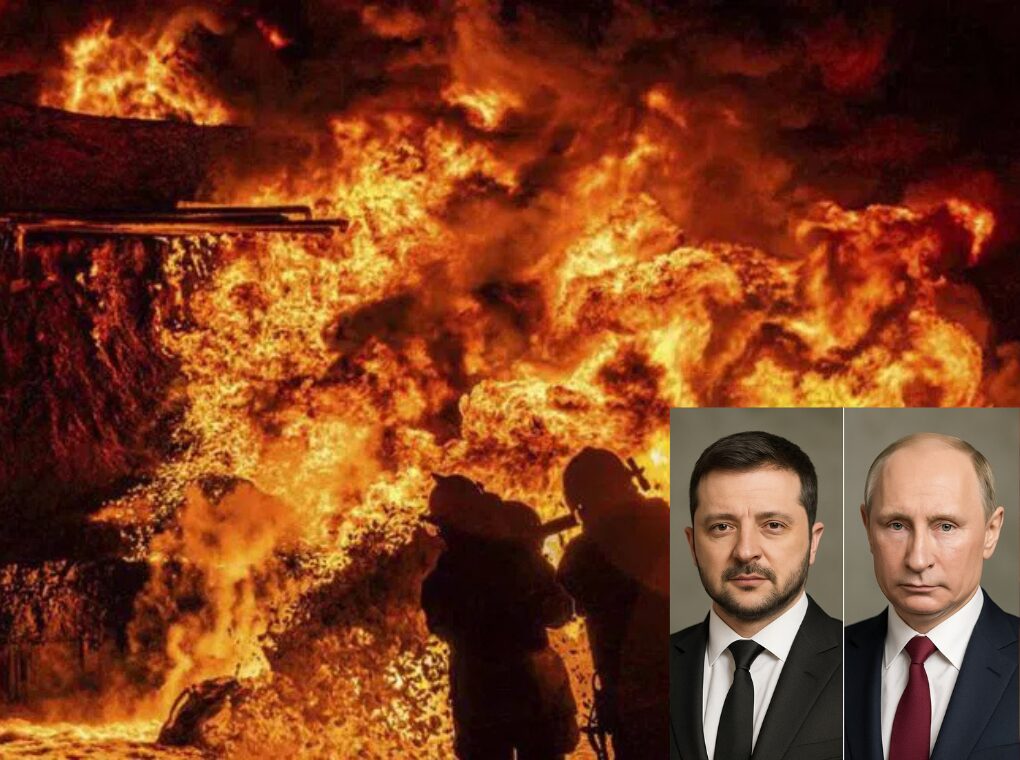On its 34th Independence Day, Ukraine launched one of its boldest escalations yet—waves of drones striking deep into Russian territory, including the Kursk nuclear power plant and the Ust-Luga energy port near St. Petersburg.
Moscow condemned the attacks as “reckless,” accusing Kyiv of endangering not only Russia but the whole of Europe by targeting sensitive energy infrastructure. The Kremlin warned that striking nuclear facilities was a red line, while Western analysts acknowledged the growing risks of such operations.
As the world debates what these strikes mean, questions are rising: Was this a tactical victory for Kyiv, or a desperate gamble to stall peace?
The Drone Strikes
According to Russian officials, several key facilities came under attack overnight:
Kursk Nuclear Power Plant: A Ukrainian drone damaged a transformer, forcing one reactor to reduce output. Though radiation levels remained within normal ranges, the UN nuclear watchdog quickly issued a statement warning that “every nuclear facility must be protected at all times.”
Ust-Luga Port, Leningrad Region: Around 10 drones struck near fuel storage tanks, igniting a fire. This port processes millions of tons of liquefied natural gas and fertilizers every year, vital not only to Russia but also to global markets in Europe and Asia.
Ukraine did not immediately comment on the strikes. But the choice of targets made Kyiv’s intention clear: cripple Russia’s energy infrastructure at its most sensitive points.
Moscow responded the same night, launching waves of Shahed drones and missiles against Ukrainian energy grids, striking transformers and transmission lines.
Recklessness on Independence Day
The timing was symbolic. Rather than marking its national day with peace or unity, Ukraine chose escalation—directly targeting nuclear facilities and energy hubs.
President Volodymyr Zelenskyy’s Independence Day address in Kyiv proclaimed:
“We are building a Ukraine strong enough to live in security and peace.”
But critics pointed to the contradiction: hours earlier, his government approved strikes that risked a nuclear accident on European soil.
Russian officials labeled the actions “hypocrisy,” while even neutral observers questioned whether Ukraine was truly pursuing peace—or prolonging a dangerous war.
Trump’s “Two Weeks” Ultimatum
The escalation also comes against the backdrop of shifting U.S. policy.
President Donald Trump has reportedly given a two-week deadline for possible peace negotiations in both Ukraine and the Middle East. Reports suggest Trump is considering a deal with Russian President Vladimir Putin that could freeze the conflict.
For Zelenskyy, this is a nightmare scenario. Any U.S.–Russia understanding might force Ukraine into territorial concessions—and potentially end his political career.
Thus, critics argue, Ukraine escalated at precisely the moment peace was being discussed—an attempt to tie Trump’s hands and make any deal with Moscow politically impossible.
Why Europe Blocks Peace?
Europe’s role is equally important.
The European Union has consistently rejected calls for a quick peace settlement, despite the economic strain of sanctions and rising energy costs. Analysts point to three main reasons:
Fear of U.S.–Russia Rapprochement: The EU is uneasy about the warming ties between Trump and Putin, who recently signaled their willingness to remove differences and boost trade. A U.S.–Russia thaw would sideline Brussels.
Dependence on U.S. Protection: A peace deal could allow Washington to withdraw troops from Europe and shift its focus toward China and the Indo-Pacific. Without American forces, Europe knows it lacks the military capability to defend itself against Russia.
NATO’s Relevance: NATO’s strength rests on having Russia as a permanent enemy. If peace comes, NATO’s purpose and Europe’s leverage over Washington could weaken.
This is why European leaders, alongside Zelenskyy, visited Washington in recent weeks—urging Trump not to accept Moscow’s terms. For Brussels, keeping U.S. boots on European soil matters more than ending the war.
Zelenskyy’s Political Survival
For Zelenskyy, prolonging the war is also about survival.
Ukraine remains plagued by corruption; a fact even Western watchdogs admit. Billions in foreign aid have disappeared into opaque networks, fueling suspicions that wartime chaos benefits certain elites.
If peace were to come, Zelenskyy would be forced to hold elections—polls suggest he would likely lose. By dragging the war on, he avoids facing voters, maintains Western support, and secures his political position.
From Moscow’s perspective, this confirms their view: Kyiv is not fighting for peace or sovereignty, but to preserve its regime.
Russia’s Response
So far, Russia’s response has been measured. The Kursk fire was contained quickly, and radiation levels never spiked.
But the Kremlin has warned that such escalations will not go unanswered. Striking nuclear and strategic energy infrastructure crosses red lines. Russia retains vast military, cyber, and economic tools—and will respond on its own terms.
While Kyiv’s Western backers celebrate the audacity of the strikes, Moscow insists: Russia cannot be intimidated on its own soil.
The Bigger Picture
These strikes must also be understood in a broader geopolitical context:
Economic Pressure: The U.S. is tightening tariffs on BRICS nations like Brazil, India, and China—countries that continue buying Russian oil and gas.
Shifting Trade: Despite sanctions, U.S.–Russia trade has risen 20% in recent months, evidence that rhetoric and reality often diverge.
Global Divide: While Europe clings to NATO, Russia is expanding partnerships in Asia, presenting itself as a counterweight to Western dominance.
For many, Ukraine’s escalation is not just a battlefield tactic—it’s part of the wider contest between East and West over who sets the rules of the 21st century.
The Real Independence Day Message
So, what was Ukraine’s real message on its Independence Day?
Not independence. Not peace. But escalation.
By striking nuclear and energy facilities, Kyiv gambled with global security. By escalating on the eve of potential peace talks, it revealed its fear of a U.S.–Russia deal. By continuing the war, Zelenskyy secured Western money and political survival—at the cost of stability.
As Moscow warns of retaliation, one reality is becoming clearer:
Ukraine doesn’t want peace. Europe doesn’t want peace. And Zelenskyy cannot afford peace.
Russia, meanwhile, insists it will respond—firmly but on its own terms—reminding the world why it cannot be coerced, intimidated, or destabilized.
